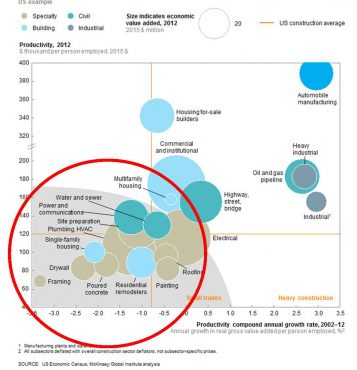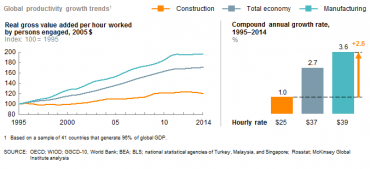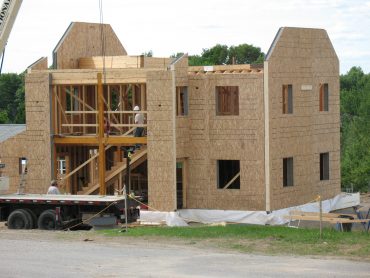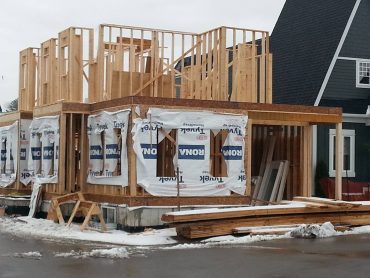
John Bleasby
Productivity, NZE, skilled labor shortages: Perfect storm or perfect opportunity?
Canadian ContractorBig challenges and opportunities lie ahead for residential construction
As we near the conclusion of the century’s second decade in 2020, it shouldn’t be hard for the residential construction industry to see changes coming down the road. Those contractors who wish to thrive and prosper in the years ahead should seriously consider the big moves that await, and start planning to take advantage.

Note how most of the building trades fall in the lowest quadrant of this efficiency-gain chart…’framing’ almost being the worst in efficiency gains! (McKinsey graphics)
Productivity problems in the construction industry
While many industries around the globe move ahead in terms of productivity, a recent McKinsey Global Institute report suggests that the construction industry is in a deep funk.
While manufacturing and retail industry have embraced and expanded various ways to automate and improve efficiency, McKinsey reports that, “in comparison, much of construction has evolved at a glacial pace. Globally, labor-productivity growth in construction has averaged only 1.0 per cent a year over the past two decades, compared with growth of 2.8 per cent for the total world economy and 3.6 per cent in the case of manufacturing. In a sample of countries analyzed, over the past ten years less than one-quarter of construction firms have matched the productivity growth achieved in the overall economies in which they work.”
Yet demand for housing across all sectors, from high-value custom homes to lower cost public housing, is destined to increase over the next several decades. “Despite huge potential for additional value added, and despite the fact that the challenges are well known and have been long discussed in the industry, progress has been limited,” the McKinsey report continues.

On a global basis, the value of work performed per dollar in construction has barely moved in two decades! (McKinsey graphics)
Why the lag in productivity despite the growth in demand? To a large degree it’s because most houses built today are put together more or less the way they were 50 years ago by builders and designers reluctant to commit to new materials and technologies. New ideas are, for the most part, restricted to specialized custom homes.
Skilled labor shortages are inevitable
In contrast to many industries expressing concerns about automation taking away jobs of the future, the construction continues to cry out for more skilled workers. Major initiatives are underway all over North America to engage young people in the trades and to increase the career lengths of those already employed by improved lifting and tool technologies. Nevertheless, the shortfall remains and is likely to stay that way as the current generation of skilled workers now aged 40-55 years reach retirement.
Net Zero Energy; Coming to a house near you!
As outlined in a Canadian Contractor post last October, the Canadian Federal government has ambitious goals for the reduction of greenhouse gasses (GHG) produced in Canada. By 2030 all new homes in Canada will be built to Net Zero Energy Ready (NZEr) standards, if the Liberal government has its way.
It is best not to be complacent about this. Like the code changes from the 1980’s that led to the R2000 standards, ZNE/ZNRr codes would have a significant impact on the industry. “When R2000 came out in the ‘80’s, it was a pretty radical notion,” recalls CHBA director of communications, David Foster. “It took a number of years for the industry to figure out how to do it in a practical, affordable and durable way.”

SIPs (Structured Insulated Panels) are suitable for both large custom homes and developments, and need only a small crew to assemble.
And there’s more. Canada’s national building codes may be changing even sooner, over the next five years in fact, to adapt to the effects of climate change. It has been reported, for example, that the National Research Council (NRC), the organization that sets “model codes” for building, energy, plumbing and fire, is working on updating building codes to reflect the impact of extreme weather such as storms, high winds, and flooding.
The perfect storm, or the perfect opportunity
Where one person sees obstacles, another will see opportunities. The question to be asked is, “What will it take for the residential construction industry to change its ways? Who will be the early adopters of techniques that combine high productivity, more efficient use of a limited skilled trades supply, and energy efficiency?”
For example, those clients seeking energy efficient custom homes can choose ICF and related products, but only if designers and builders are properly aware and trained in their application. These newer materials allow a building crew to take on tasks that previously required other specialized teams, thus reducing the required size and complexity of the workforce.

This new-build home in a development north of Toronto will sell for over $600,000, yet is built the way most low-priced homes are constructed, unchanged in nearly 50 years.
As for multi-dwelling developments, the trend of building the way it’s been done for the past half century continues largely unabated, that is to say, with no measurable gains in productivity, as the McKinsey report suggests, and with no tangible moves towards NZE either. Stick construction on top of a poured concrete foundation wall still dominates today’s development sites. The same number of workers is required as always, even in the face of a skilled labor shortage both now and in the future. That will have to change.
Buildings using manufactured products such as SIPs (Structured Insulated Panels) would seem to point the way for both custom and tract housing builders to embrace all three factors; productivity, skilled labour shortages, and NZE. The smart and successful builders of the next decade will be making those strategical moves now.
Regulations will rule the day
The good news is that there are builders, including some leading names in large scale development, willing to make changes to their designs, construction techniques and energy efficiency ahead of inevitable regulatory change. Sadly, it will likely take those new regulations and building codes to force similar improvements on the others reluctant to embrace change today.
What do you think? Will it take regulations like building codes to motivate the industry to change?
Follow John on Instagram and on Twitter for notifications about our newest posts
Advertisement
Print this page



Labour shortage
On an island out here in the Pacific the younger people are in their 60’s so no local labour available, so I choosing prefabs homes from Purcell Timber Frame and Trout Creek sips because their crews can come to install. Speed of construction is fast and I don’t have to lift anything.
I also always use Insulated Concrete Forms for foundations for these packages, again very fast and economical.
We just hosted an AMVIC ICF course in Burnaby BC and had over 30 attendees, most of whom have never seen ICF before and are feeling the need to convert from tradition and attempt their first ICF builds. On March 9th, Vancouver ICF hosted and ICF Expo where builders were told by forming contractors who recently switched completely to ICF , they would never touch plywood forms again. Now their careers are prolonged by 15 years. BC building code changes are leading smart builders to get on the bandwagon now with R-30 ICF walls for future builds to meet stiffer codes. Could be r-32 in 10 yearsBill McCance
I appreciate your article John and your continued reporting and commentary; thanks for keeping us thinking.
I believe the chart/study is somewhat misleading. What it doesn’t take into account is that although in manufacturing the labour efficiency has improved by 2.8% in building the same widget. In construction the actually product has improved exponentially and yet we have still managed to improve our efficiency by 1%. I would say, “well done guys!”.
Not to mention we also didn’t produce thousands and thousands of dollars in engineering/computer/and technology fees to achieve this efficiently. Therefore not only have we become more efficient but also better value.
NOTE: the actually time/cost of labour (even thought the product/house has gotten better and more complicated) has not increased significantly in 20 years either.
(Of course the redtape/government/taxes/land fees have certainly in creased the final cost of the house.)
Thanks Rudy, and I will be going into more detail about productivity gains (or not) in construction in an upcoming post. Just anecdotally though, as I drive around my area I see new homes under construction ranging from $279,000 to over $1 million. (I will be posting pictures). In almost every case, these new homes are built the same way: a poured concrete foundation wall, stick construction, OSB sheeting,Typar wrap, then siding…. and nothing to deal with thermal bridging. In other words, they are the same as houses built 20+ years ago. They require the same number of crew, they are built with the same methodology. Exponentially improved? I beg to differ. We can agree to disagree on a case-by-case examination, of course. I will also admit that manufacturing autos is not the same as building a house. However you will have a hard time convincing me that the advances in construction techniques now available are being accepted by most builders, unless of course building codes force them. Canadian Contractor will of course highlight and celebrate those builders who are embracing the new materials and processes which can positively impact productivity and meet the other challenges I outline briefly in my post. Overall though, there is much more than can be done by the majority.